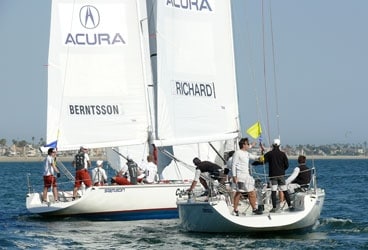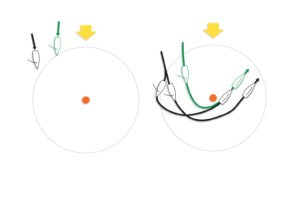
pre start work 368
Getting a good start is an essential part of doing well in sailboat races-that much we all know. There are tricks and techniques specific to just about every flavor of start. But there’s one fundamental technique that will help a team’s chances of getting off the line in good shape no matter how it chooses to cross the starting line: it’s something we call the “division of labor.”
The concept is simple, but effective: assign specific jobs to the right people onboard and make sure each person focuses on doing his or her job, no matter what else is going on in the pre-start.
In setting up the division of labor for a pre-start, it’s important that each crewmember is comfortable and confident they can do their assigned job in a consistent manner. Consistent is the key word here. It order for the division of labor to be effective, each crewmember must remain focused on their assignment regardless of what else is happening. One of the most common errors a crewmember can make during a start is to neglect their assignment in order to watch what is happening off the boat. For example, if the entire crew’s attention is drawn to the bow of a leeward boat that is luffing up during the pre-start, then the crew assigned to watch up the course could miss a big wind shift or not see that a quick tack could result in a good start somewhere up the line. Likewise, the trimmers might lose track of their sail trim and fail to keep the boat at maximum speed. If each crewmember focuses on their assigned role, then only the helmsman and maybe one other crewmember should be watching that leeward boat.
In an article with Curtis Florence (Sailing World, May 2009), the veteran bowman talks about his role in getting a boat to the starting line on time. I won’t go over that again here; just go back and read the article (www.sailingworld/0911florence). However, one bowman responsibility that Florence doesn’t mention in that story is judging whether your boat is overlapped or clear behind a boat ahead. This knowledge is vital for the helmsman in a match-racing situation, and it can also be very important in fleet racing. Most bowmen use a swinging-arm motion to indicate that the bow is clear to swing past a transom.
In addition to the bowman’s duties, there are several assignments that should be given to individual crewmembers, thereby taking the load off the helmsman and the tactician. One of the most obvious roles is calling the time to the start. Only one person should be in charge of this countdown, and they shouldn’t have any other time-related responsibilities during the start. I like to know that when I hear this crewmember’s voice, I’m hearing the time remaining until the starting gun. If that same person were, for example, calling the time remaining to the line, things could get very confusing for those at the back of the boat. In general, most boats do not call the time frequently enough. I like to hear it every 15 seconds until 1 minute remaining, then every 5 seconds until the last 15 seconds, which should be counted down individually. The person calling the time to the start should also be listening to the VHF radio for race committee communications-such as a course change or OCS calls-during and after the start.
Another often overlooked assignment is calling out time to the starting line and time to the layline. The bowman can do this, but it’s best to have someone further back in the boat helping during the early stages of the prestart. Knowing how long it’s going to take to get to the boat or the pin end of the line is a huge help when converging with a group of boats on the opposite tack. If he knows the pack is early for the pin end, for example, the tactician or helmsman can let them sail past and tack on the weather side. This same person can also help with calling the laylines to the ends of the line. If you tack in front of a group of boats making a well timed approach to the pin, but then can’t lay the mark, your start is doomed.
The three roles listed above are all related to the start at hand. But it’s also important to have a set of eyes on the future-what will happen after the starting gun-to ensure you’re on the right place on the line. Make sure your team has a plan as to where you would prefer to start. Even if you have minimal confidence in your plan, making the plan known to the entire team before the 5-minute gun will get everyone on the same page and working toward that goal. During the pre-start, someone on the boat must always be thinking about the big picture. A lot can change during a 5-minute pre-start. The helmsman and tactician might miss the clues because they’re so focused on the start. So one set of eyes needs to be looking upwind to see if the game plan needs to the changed. If he or she notices a significant change-a windshift or a marked change in velocity, then the tactician must be informed. The tactician can then decide whether to change the plan. As a tactician, it’s always frustrating to work so hard toward a killer start only to find that you’re on the wrong side of a huge shift.
What I have described here are basic assignments that should be given out to the crew. The size of your boat will determine how many people there are to do these jobs. On a Laser, you’re in charge of all of them, but on a bigger boat, there are enough jobs to keep most everyone busy during the pre-start, especially when you factor in the trimming and grinding that also have to happen at the same time. Make sure the roles on board are evenly spread and clearly defined so there are no questions as to who is doing what. One ancillary benefit of this system is that it keeps more of the crew actively involved in the performance of the boat, which makes the team perform better and the racing more fun for everyone.
Duty Calls
Whether fleet racing or match racing (as at the 2009 Congressional Cup, above) it’s important
to assign each crewmember a job for the pre-start. Here’s how the assignments could be dolled out
for a six-person crew:
Helmsman: Watch bowman for call on whether bow is free to swing. Manage boatspeed with trimmers.
Tactician: Regularly check up the course. Decide whether to confirm or change starting-line position. Help with time to line and laylines.
Trimmers: Trim for maximum speed unless told otherwise.
Mast/pit: Call time to the start, tail jib for jib trimmer.
Bow: Indicate whether bow is free to swing, call distance to line.









